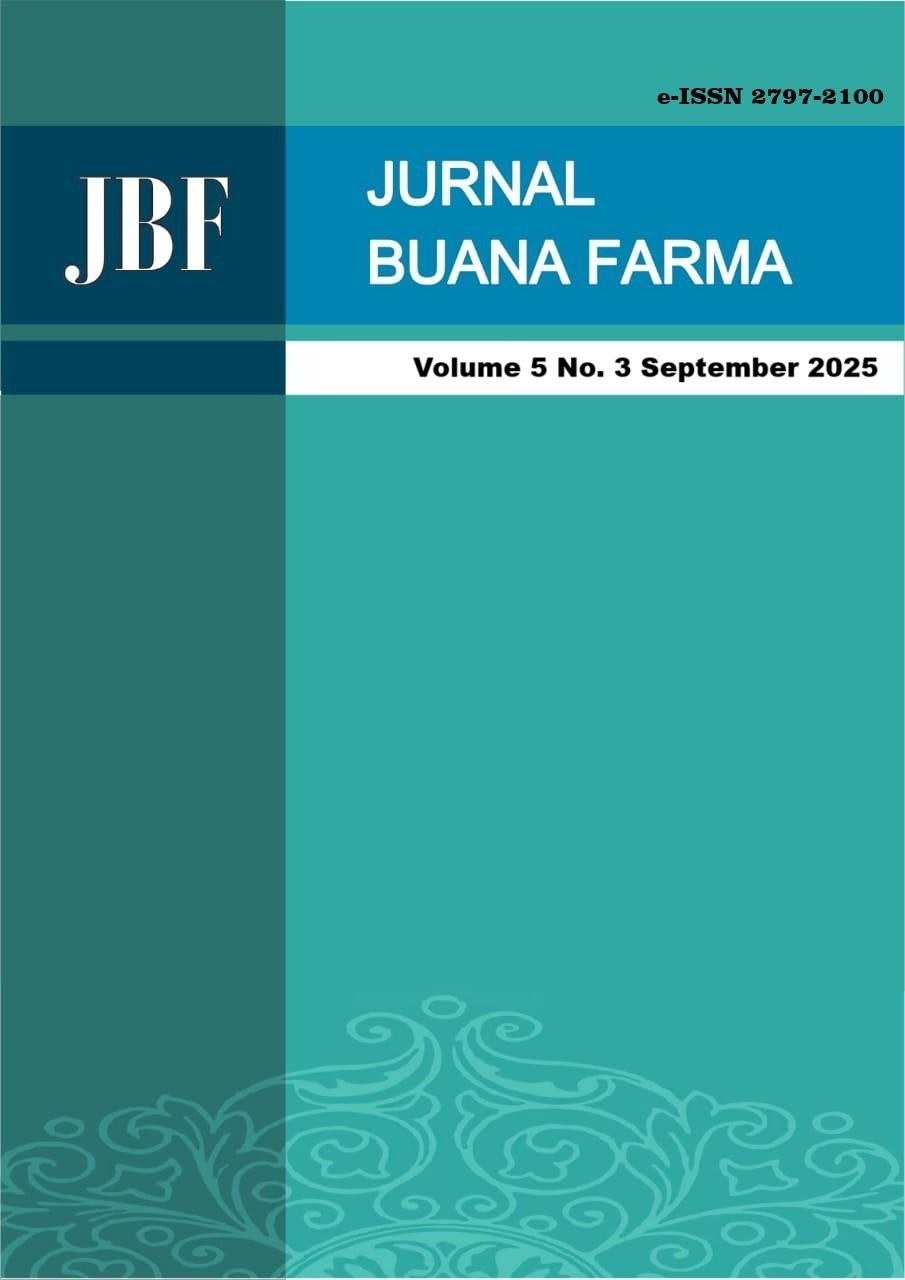AKTIVITAS ANTIJAMUR FRAKSI KAYU SECANG TERHADAP Candida albicans DAN BIOAUTOGRAFI
Indonesia
Abstract
Sappan (Caesalpinia sappan L.) is a plant of the Caesalpiniaceae family that is used for traditional medicine. Utilized Secang (Caesalpinia sappan L.) is a plant from the Caesalpiniaceae family whose wood has long been used in traditional medicine and contains compounds such as brazilin, flavonoids, saponins, propane, tannins, and terpenoids with potential antifungal activity. Fungal infections, particularly Candida albicans, remain common health problems, and although antifungal drugs such as fluconazole are widely used, resistance cases continue to increase. This study aimed to evaluate the antifungal activity of secang wood extract and its fractions against C. albicans and to identify the most active compound group using thin-layer chromatography (TLC) bioautography. Secang wood was extracted by maceration with 96% ethanol and fractionated with n-hexane, ethyl acetate, and water, followed by antifungal testing using the paper disc diffusion method at concentrations of 6%, 9%, and 12%, with fluconazole as a positive control and 3% DMSO as a negative control. Data were analyzed using two-way ANOVA and showed normal distribution (Sig > 0.05). The results demonstrated that the extract, n-hexane fraction, ethyl acetate fraction, and water fraction inhibited the growth of C. albicans, with the water fraction at 12% producing the largest inhibition zone of 16.19 mm, categorized as strong activity. TLC bioautography of the water fraction revealed the presence of tannins as active compounds responsible for antifungal activity.
References
Agustina, E., Andiarna, F., Hidayati, I., & Kartika, V. F. (2021). Uji aktivitas antijamur ekstrak black garlic terhadap pertumbuhan jamur Candida albicans. BIOMA: Jurnal Ilmiah Biologi, 10(2), 143–157.
Ayu Ida, P. E., Desi Bintari, N. W., Idayani, S., & Damayanti, I. A. M. (2023). Gambaran jamur Candida albicans pada urin pra-menstruasi mahasiswi Stikes Wira Medika Bali. Jurnal Riset Kesehatan Nasional, 7(2), 84–90. https://doi.org/10.37294/jrkn.v7i2. 499
Badan Pengawas Obat dan Makanan Republik Indonesia. (2013). Pedoman penyiapan bahan baku obat bahan alam berbasis ekstrak/fraksi (Cetakan pertama, Issue November). Badan Pengawas Obat dan Makanan Republik Indonesia.
Cahyaningtyas, D. M., Puspawati, N., & Binugraheni, R. (2019). Uji aktivitas antibakteri ekstrak etanolik kayu secang (Caesalpinia sappan L.) terhadap Staphylococcus aureus. Jurnal Biomedika, 12(2), 205–216
Erwan, O. M., & Parbuntari, H. (2023). Identifikasi senyawa metabolit sekunder pada daun salam (Syzygium polyanthum). Jurnal Periodic Jurusan Kimia UNP, 12(3), 39–39.
Habibi, A. I., Firmansyah, R. A., & Setyawati, S. M. (2018). Skrining fitokimia ekstrak n-heksan korteks batang salam (Syzygium polyanthum). Indonesian Journal of Chemical Science. Universitas Islam Negeri Walisongo.
Harborne, J. B. (1987). Metode fitokimia: Penuntun cara modern menganalisis tumbuhan. Bandung: Penerbit ITB.
Harborne, J. B. (2006). Phytochemical methods: A guide to modern techniques of plant analysis (3rd ed.). Springer Science & Business Media.
Karlina, Y., Adirestuti, P., Agustini, D. M., Fadhillah, N. L., & Malita, D. (2020). Pengujian potensi antijamur ekstrak air kayu secang terhadap Aspergillus niger dan Candida albicans. Chimica et Natura Acta, 4(1), 84–87.
Khaira, R. (2020). Identifikasi jamur Candida albicans pada bak penampungan air di toilet umum. Journal of Pharmacy and Science, 3(1).
Latirah. (2021). Color test extract of secang (Caesalpinia sappan L.), gambier (Uncaria gambir Roxb.), and areca seeds (Areca catechu L.). Jurnal Teknologi dan Seni Kesehatan, 12(1), 53–61.
Listiani, B., Meidyawati, R., Npa, D. A.Y. U., & Arniawaty, D. W. I. (2019). Antifungal efficacy of secang heartwood (Caesalpinia sappan L.) solution on biofilm Candida albicans. International Journal of Pharmaceutics, 11(1), 5–8.
Melsi, K., Nopiyanti, V., & Rejeki, E. S. (2022). Uji aktivitas antioksidan fraksi n-heksan, etil asetat, dan air ekstrak daun biwa (Eriobotrya japonica (Thunb.) Lindl.) dengan metode DPPH. As-Syifaa: Jurnal Farmasi, 14(2), 83–88.
Paputungan, W. A., Lolo, W. A., & Siampa, J. P. (2019). Aktivitas antibakteri dan analisis KLT- bioautografi dari fraksi biji kopi robusta (Coffea canephora Pierre ex A. Froehner). Pharmacon, 8(3), 516.
Rachmania, R. A., Dwitiyanti, D., Iriansyah, Q. W., & Putri, F. F. (2021). Potensi fraksi kayu secang (Caesalpinia sappan L.) terhadap penghambatan xantin oksidase dalam menurunkan kadar asam urat pada hiperurisemia. Pharmacy: Jurnal Farmasi Indonesia, 18(1), 21.
Rizki, S. A., Latief, M., Fitrianingsih, Rahman, & Havizur. (2021). Uji aktivitas antibakteri ekstrak n- heksan, etil asetat, dan etanol daun durian (Durio zibethinus Linn.) terhadap bakteri Propionibacterium acnes dan Staphylococcus epidermidis. JMJ: Jurnal Medika Jambi, 4(1), 442–457.
Rukmana, M. R., Nughroho, B. R., & Wisnumurti, A. D. (2020). Uji resistensi isolat khamir yang diisolasi dari limbah industri di Rungkut, Surabaya, Indonesia. Jurnal Bioeksperimen, 6(2), 133–
Suhartinah, S. (2023). Uji aktivitas sediaan gel ekstrak daun kenikir (Cosmos caudatus Kunth) terhadap kecepatan penyembuhan luka sayat pada punggung kelinci. Intan Husada: Jurnal Ilmiah Keperawatan, 11(1), 1–14.
Suraini, & Enlita. (2019). Uji potensi ekstrak kayu secang (Caesalpinia sappan L.) dalam menghambat pertumbuhan jamur Candida albicans. Jurnal Upertis, 8(1), 47–56.
Yasir, Y., Rusli, & Asmita. (2021). Antifungal activity test of ethanol extract of secang wood (Caesalpinia sappan L.) against Candida albicans. Jurnal Novem Medika Farmasi, 10–17. Universitas Islam Makassar.













